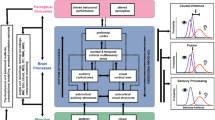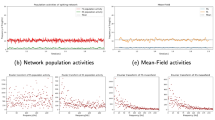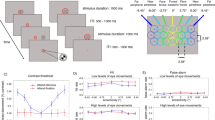Abstract
A dynamical neural network model of binocular stereopsis is proposed to solve the problem of segmentation which remains ambiguous even when the problem of binocular correspondence is solved. Being compatible with the recent neurophysiological findings (Engel et al. 1991), the model assumes that neural cells show oscillatory activities and that segmentation into a coherent depth surface is coded by synchronization of activities. Employing appropriate constraints for segmentation, the present model shows proper segmentation of depth surfaces and also solves segmentational ambiguity caused by a gap. It is newly shown that binocularly-unmatched monocular cells are discriminated in temporal segmentation of monocular cells caused by recurrent interactions between monocular and binocular cells. Integrative interactions with the other visual components through temporal segmentation are also discussed.
Similar content being viewed by others
References
Akerstrom RA, Todd JT (1988) The perception of stereoscopic transparency. Percept Psychophys 44:421–432
Amari S, Arbib MA (1977) Competition and cooperation in neural nets. In: Metzler J (eds) System neuroscience. Academic Press, New York, pp 119–165
Barlow HB, Blakemore C, Pettigrew JD (1967) The neural mechanism of binocular depth discrimination. J Physiol 193:327–342
Bolz J, Gilbert CD, Wiesel TN (1989) Pharmacological analysis of cortical circuitry. Trends NeuroSci 8:292–296
Eckhorn R, Bauer R, Jordan W, Brosch M, Kruse W, Munk M, Reitboeck HJ (1988) Coherent oscillations: a mechanism of feature linking in the visual cortex? Biol Cybern 60:121–130
Eckhorn R, Reitboeck HJ, Arndt M, Dicke P (1990) Feature linking via synchronization among distributed assemblies: simulations of results from cat visual cortex. Neural Comp 2:293–307
Engel AK, Konig P, Singer W (1991) Direct physiological evidence for scene segmentation by temporal coding. Proc Natl Acad Sci USA 88:9136–9140
Ferster D (1981) A comparison of binocular depth mechanisms in areas 17 and 18 of the cat visual cortex. J Physiol 311:623–655
Freeman WJ (1987) Simulation of chaotic EEG patterns with a dynamic model of the olfactory system. Biol Cybern 56:139–150
Frisby JP (1980) Seeing: Illusion, brain and mind. Oxford University Press, Oxford
Gilbert CD (1985) Horizontal integration in the neocortex. Trends NeuroSci 8:160–165
Gilbert CD, Wiesel TN (1979) Morphology and intracortical projections of functionally characterised neurons in the cat visual cortex. Nature 280:120–125
Gilbert CD, Wiesel TN (1989) Columnar specificity of intrinsic horizontal and corticocortical connections in cat visual cortex. J Neurosci 9:2432–2442
Gray CM, Singer W (1989) Stimulus-specific neuronal oscillations in orientation columns of cat visual cortex. Proc Natl Acad Sci USA 86:1698–1702
Gray CM, Konig P, Engel AK, Singer W (1989) Oscillatory responses in cat visual cortex exhibit inter-columnar synchronization which reflects global stimulus properties. Nature 338:334–337
Grossberg S, Somers D (1991) Synchronized oscillations during cooperative feature linking in a cortical model of visual perception. Neural Networks 4:453–466
Hirsch JA, Gilbert CD (1991) Synaptic physiology of horizontal connections in the cat's visual cortex. J Neurosci 11:1800–1809
Hubel DH, Wiesel TN (1977) Functional architecture of macaque monkey visual cortex. Proc R Soc London Ser B 198:1–59
Julesz B (1971) Foundations of cyclopean perception. University of Chicago Press, Chicago
Julesz B (1984) Toward an axiomatic theory of preattentive vision. In: Edelman GM, Gall WE, Cowan WM (eds) Dynamic aspects of neocortical function. Wiley, New York, pp 585–612
Kammen DM, Holmes PJ, Koch C (1989) Cortical architecture and oscillations in neuronal networks: feedback versus local coupling. In: Cotterill RMJ (eds) Models of brain function. Cambridge Univ Press, Cambridge, pp 273–284
Koffka K (1935) Principles of Gestalt psychology. Routledge & Kegan Paul, London
Konig P, Schillen TB (1991) Stimulus-dependent assembly formation of oscillatory responses: I. synchronization. Neural Comp 3:155–166
LeVay S, Voigt T (1988) Ocular dominance and disparity coding in cat visual cortex. Visual Neurosci 1:395–414
Li Z, Hopfield JJ (1989) Modeling the olfactory bulb and its neural oscillatory processing. Biol Cybern 61:379–392
Livingston MS, Hubel DH (1987) Psychophysical evidence for separate channels for the perception of form, color, movement, and depth. J Neurosci 7:3416–3468
Malsburg C von der (1985) Nervous structures with dynamical links. Ber Bunsenges Phys Chem 89:703–710
Malsburg C von der, Schneider W (1986) A neural cocktail-party processor. Biol Cybern 54:29–40
Marr D (1982) Vision. Freeman, New York
Marr D, Poggio T (1976) Cooperative computation of stereo disparity. Science 194:283–287
Marr D, Palm G, Poggio T (1978) Analysis of a cooperative stereo algorithm. Biol Cybern 28:223–239
Martin KAC, Somogyi P, Whitteridge D (1983) Physiological and morphological properties of identified basket cells in the cat's visual cortex. Exp Brain Res 50:193–200
Nakayama K, Shimojo S, Silverman GH (1989) Stereoscopic depth: its relation to image segmentation, grouping, and the recognition of occluded objects. Perception 18:55–68
Nakazawa H (1990) Roles of surface in binocular stereopsis. Master's thesis, University of Tokyo (in Japanese)
Neisser U (1967) Cognitive psychology. Appleton-Century-Crofts, New York
Poggio GF, Fischer B (1977) Binocular interaction and depth sensitivity in striate and prestriate cortex of behaving rhesus monkey. J Neurophysiol 40:1392–1405
Poggio GF, Gonzalez F, Krause F (1988) Stereoscopic mechanisms in monkey visual cortex: binocular correlation and disparity selectivity. J Neurosci 8:4531–4550
Poggio GF, Motter BC, Squatrito S, Trotter Y (1985) Responses of neurons in visual cortex (V1 and V2) of the alert macaque to dynamic random-dot stereograms. Vision Res 25:397–406
Pollard SB, Mayhew JEW, Frisby JP (1985) PMF: A stereo correspondence algorithm using a disparity gradient limit. Perception 14:449–470
Prazdny K (1985) Detection of binocular disparities. Biol Cybern 52:93–99
Ramachandran VS (1986) Capture of stereosis and apparent motion by illusory contours. Percept Psychophys 39:361–373
Reitboeck HJ, Eckhorn R, Arndt M, Dicke P (1990) A model for feature linking via correlated neural activity. In: Haken H, Stadler M (eds) Synergetics of cognition. Springer, Berlin Heidelberg New York, pp 112–125
Schuster HG, Wagner P (1990) A model for neural oscillations in the visual cortex. Biol Cybern 64:77–82
Shimizu H, Yamaguchi Y (1987) Synergetic computers and holonics — information dynamics of a semantic computer. Phys Scr 36:970–985
Shimizu H, Yamaguchi Y (1991) The self-organization of neuronal representations of semantic information of vision. In: Holden AV, Kryukov VI (eds) Neurocomputers and attention I: neurobiology, synchronization and chaos. Manchester University Press, Manchester New York, pp 383–403
Shimizu H, Yamaguchi Y, Tsuda I, Yano M (1985) Pattern recognition based on holonic information dynamics towards synergetic computers. In: Haken H (eds) Complex systems — operational approaches. Springer, Berlin Heidelberg New York, pp 225–239
Somogyi P, Cowey A, Kisvarday ZF, Freund TF, Szentagothai J (1983) Retrograde transport of gamma-amino[3H]butyric acid reveals specific interlaminar connections in the striate cortex of monkey. Proc Natl Acad Sci USA 80:2385–2389
Sporns O, Tononi G, Edelman GM (1991) Modeling perceptual grouping and figure-ground segregation by means of active reentrant connections. Proc Natl Acad Sci USA 88:129–133
Szentagothai J (1983) The modular architectonic principle of neural centers. Rev Physiol Biochem Pharmacol 98:11–61
Treisman A (1986) Properties, parts, and objects. In: Boff KR, Kaufman L, Thomas JP (eds) Handbook of perception and human performance, vol 2. Wiley, New York, Chap 35, pp 1–70
Yano M, Suzuki S, Shimizu H (1988) The model of color recognition. IEICE Technical Report (Japan) MBE87-148 (in Japanese)
Wilson MA, Bower JM (1991) A computer simulation of oscillatory behavior in primary visual cortex. Neural Comp 3:498–509
Author information
Authors and Affiliations
Rights and permissions
About this article
Cite this article
Murata, T., Shimizu, H. Oscillatory binocular system and temporal segmentation of stereoscopic depth surfaces. Biol. Cybern. 68, 381–391 (1993). https://doi.org/10.1007/BF00198771
Received:
Accepted:
Issue Date:
DOI: https://doi.org/10.1007/BF00198771




